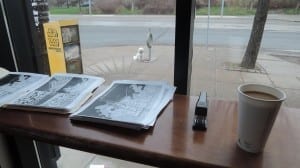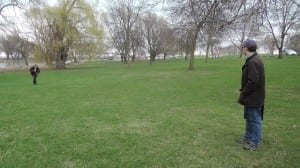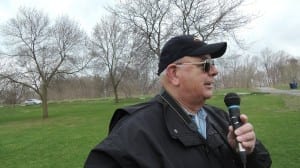May 3, 2014 Jane’s Walk shares conversations about 1940s, ’50s, & ’60s events in Mississauga and Long Branch (Toronto not New Jersey)
Mike James and Jaan Pill are now in their third year of organizing Jane’s Walks in Long Branch (Toronto not New Jersey).
The Saturday, May 3, 2014 Jane’s Walk began at our usual time and location – at 10:30 am at the East Parking Lot at Marie Curtis Park. The walk was called Inspiration Lakeview: Proactive, Persistent, and Positive.

Enjoying a coffee, early in the morning, while stapling handouts for the May 3, 2014 Long Branch Jane's Walk. The handouts were a couple of pages from an impressive March 18, 2014, 97-page online document that provides an overview of the Inspiration Lakeview redevelopment project to the west of Long Branch. The document is accessible from the Preserved Stories website. Jaan Pill photo

On land on the the west side of Etobicoke Creek - which at this point is still in Toronto - you can see a clear pathway through the trees as you look south toward Lake Ontario. This is where Island Road used to run until the 1950s. The current roadway that is named Island Road has the same name - but it's located some distance to the west, as David Webster explained, from its original location. Jaan Pill photo
This wasn’t the original title. I had posted a much longer title but a Jane’s Walk Outreach Intern contacted me and suggested the shorter title. The final title that we chose worked much better than the earlier one that I had come up with. I much appreciate the attention to detail that the Jane’s Walk organization demonstrates to help walk leaders to put together the best possible walks – which includes having a short and engaging title.
This walk, from my perspective, benefitted tremendously from the fact that several walk participants – that is, people in addition to the walk leaders – shared a wide range of great anecdotes related to the history of the area around the mouth of Etobicoke Creek in the 1940s, 1950s, and 1960s.
Walking conversation
In our first walk, in 2010, we had a sense that a Jane’s Walk should be in the nature of a conversation. In the second year, when we had two walks instead of one, we were also focused on the concept that a Jane’s Walk is not a lecture but is instead a conversation.
By the third year, in 2014, the standard expression that we were hearing from Jane’s Walk organizers at the Toronto head office is that we’re seeking to offer a “walking conversation” as a key element of a Jane’s Walk.
Refinement of the concept
This year we did really well with regard to the walking conversation scenario. At the end of the walk, several walk participants remarked how much they had enjoyed the anecdotes that so many different people shared. That’s what made the May 3, 2014 Jane’s Walk in Long Branch particularly successful for the 20 or 25 people who joined us for the event.
3P strategy
At the outset of the walk, Mike James referred to the 3P Strategy that has been a key organizing principle for the Inspiration Lakeview project. As I understand, the concept is closely associated with Jim Tovey’s approach to the development of the Lakeview Legacy Project, which some years ago took on the task of dealing in a constructive way with a very large tract of land in the waterfront Lakeview community in Mississauga. As Jim Tovey has remarked in an August 2013 interview, the land in question has a history of 120 years of industrial, military, and utility pollution.
In seeking community-driven solutions to the challenges facing this very large piece of land along the Mississauga waterfront, Jim Tovey and the Lakeview community developed the 3P Strategy which is based upon the following principles:
1) Proactive
Proactive: Be proactive in identifying what negatively impacts your community, and more importantly, what may negatively impact your community in the near or distant future.
2) Persistent
Persistent: Be persistent in gaining, and sharing with your community, the knowledge required to make fair, informed decisions, and to be able to engage all stakeholders in the discussion.
3) Positive
Positive: Never offer a solution to a difficult issue unless it is a positive solution. If you cannot find a solution where there are no losers, revert to the second “P,” Persistent.
Citizens leading the call
The Lakeview Ratepayers Association adopted a set of operational principles for its work. The principles applied to everything the ratepayers association did, as noted in a previous post, in “working bottom-up in a planning system that was not used to citizens leading the call for regeneration and sustainability.”
The 3P Strategy was implemented to achieve local community, shared community, bureaucratic and political buy in. The Lakeview community took the view that there must be a creative way to find solutions that did not create losers.
It was not always possible, as I’ve noted in a previous post, to create the win-win situation but it was possible to identify core values and negotiate ways to protect those interests. The attitude shifted the mind set from the usual notion of asking authorities to fix problems to one of championing a positive alternative to the status quo.
Mississauga Ward 1 Councillor Jim Tovey
As we noted in our opening remarks at the May 3, 2014 Long Branch Jane’s Walk, Jim Tovey moved from a position as president of the Lakeview Ratepayers Association to his current role as Ward 1 Councillor for the City of Mississauga.
Videos from May 3, 2014 Long Branch Jane’s Walk
By way of rounding out our discussion, I’ve posted to the Long Branch Historical Facebook Page a set of brief videos from our May 3 Jane’s Walk.
In time, we’ll post such videos to Vimeo but for a start, we’ll post them to Facebook. At the Preserved Stories site, we’ll provide links to the Facebook videos, so that visitors to my website can readily access the videos
Once we are posting such items to Vimeo, site visitors will be able to see a thumbnail of each video; for now we’re just posting the link, as we have yet to get up to speed on editing of our material and posting it to Vimeo.
Video – David Webster (42 seconds)
Our first video at this post features David Webster.
David’s participation in our May 3 walk underlines the beneficial role that social media can play in bringing long-time Long Branch residents together to share anecdotes related to local history. David originally contacted us through the Preserved Stories website some time back.
Here’s a video of one of the anecdotes that David Shared with us, as we stood near the corner of Forty Second Street and Lake Shore Blvd. West, with a view toward Lake Ontario:
Football games at the mouth of Etobicoke Creek (42 seconds)
Video – Mike James (38 seconds)
Our second video features Mike James, who grew up in New Toronto and has many memories of the local communities in the 1960s. The following video is from a stop that we made close to the leash-free dog park on the east side of Etobicoke Creek not far from Lakeshore Road East in Mississauga. In the video he speaks of the value of having access to public lands – in the past and the present:
Mike James speaks of the value of access to public lands (38 seconds)
Video – Brian Liberty (2 minutes)
At the end of our May 3, 2014 Jane’s Walk, our conversation continued at the Fair Grounds Organic Roastery and Cafe at Fortieth Street and Lake Shore Blvd. West, where walk participants enjoyed complementary coffees. In the following video, Brian Liberty describes a project in New Toronto aimed at setting up a Community Garden near the corner of Kipling Avenue and Lake Shore Blvd. West at the Ontario Hospital Grounds:
Brian Liberty describes Community Garden project in New Toronto (2 minutes)


Leave a Reply
Want to join the discussion?Feel free to contribute!